Multiscale Static Compressive Damage Characteristics of Kiwifruit Based on the Finite Element Method
Abstract
:1. Introduction
- (1)
- Determining the mechanical parameters of kiwifruit’s skin, flesh, and core through experiments.
- (2)
- Establishing a multi-scale kiwifruit compression finite element model that includes the skin, flesh, and core.
- (3)
- Simulating the stress–strain distribution and damage characteristics of kiwifruit under static compressive loads using finite element simulation software.
- (4)
- Validating the accuracy of the model by comparing simulation results with experimental data.
- (5)
- Determining the damage threshold of kiwifruit, providing theoretical and technical support for the reduction in compression damage.
2. Materials and Methods
2.1. Materials and Equipment
2.2. Measurement of Geometrical and Mechanical Properties of Fruit
2.3. Kiwifruit Compression Experiment
2.4. Finite Element Modeling and Simulation
2.4.1. Geometric Model Construction
2.4.2. Finite Element Modeling and Meshing
2.4.3. Boundary Conditions and Solutions
3. Results and Discussion
3.1. Geometrical and Mechanical Properties of Fruits
3.2. Fruit Compression Damage
3.3. Finite Element Simulation and Experimental Results Analysis
3.4. Prediction of Internal Compression Damage Behavior in Fruits
3.4.1. Analysis of Axial Stress Distribution Characteristics in Fruit
3.4.2. Analysis of Stress Distribution Characteristics in the Long Radial Direction of Fruit
3.4.3. Analysis of Stress Distribution Characteristics in the Short Radial Direction of Fruit
4. Conclusions
- (1)
- Kiwifruit is anisotropic. The skin is brittle, while the flesh and core show elasto-plasticity. Compared with the core, the flesh has a lower compressive yield stress.
- (2)
- The finite element simulation results are in good consistency with the experimental results. During compression, the stress distribution in the fruit is symmetric, with the maximum stress concentrated in the area of contact with the compression plate. With the increase in the strain level, stress gradually expands towards the core area. The destruction force of the fruit in the axial direction is greater than in the radial direction, with little difference in the compressive destruction force between the long and short radial directions.
- (3)
- The flesh tissue of kiwifruit is more susceptible to damage during compression. When the strain level is less than 5%, no significant bruising occurs in the flesh or core in the axial, long radial, and short radial directions. The stress in the flesh and core tissues increases as the strain level increases. When the strain level exceeds 5%, some flesh tissues yield and are damaged.
- (4)
- The finite element analysis method can effectively identify and predict the static compression load damage behavior of kiwifruit. However, the impact of kiwifruit’s maturity and variety on its mechanical properties still requires further study. Additionally, it is also the key direction for future research to establish scientific damage evaluation standards and obtain precise mechanical parameters of each fruit tissue. Future work will be devoted to the further optimization and refinement of the model to enhance the accuracy and applicability of damage prediction.
Author Contributions
Funding
Institutional Review Board Statement
Informed Consent Statement
Data Availability Statement
Conflicts of Interest
References
- Pinto, T. Kiwifruit, a Botany, Chemical and Sensory Approach a Review. Adv. Plants Agric. Res. 2018, 8, 383–390. [Google Scholar] [CrossRef]
- FAO Statistical Yearbook 2021—World Food and Agriculture. Available online: https://reliefweb.int/report/world/fao-statistical-yearbook-2021-world-food-and-agriculture (accessed on 4 November 2021).
- Bvenura, C.; Hermaan, N.N.P.; Chen, L.; Sivakumar, D. Nutritional and Health Benefits of Temperate Fruits. In Postharvest Biology and Technology of Temperate Fruits; Mir, S.A., Shah, M.A., Mir, M.M., Eds.; Springer: Cham, Switzerland, 2018; pp. 51–75. ISBN 978-3-319-76843-4. [Google Scholar]
- Li, K.; Liu, L.; McClements, D.J.; Liu, Z.; Liu, X.; Liu, F. A Review of the Bioactive Compounds of Kiwifruit: Bioactivity, Extraction, Processing and Challenges. Food Rev. Int. 2023, 1–32. [Google Scholar] [CrossRef]
- Zhang, S.; Ma, J.; Zhang, L.; Sun, Z.; Zhao, Z.; Khan, N. Does Adoption of Honeybee Pollination Promote the Economic Value of Kiwifruit Farmers? Evidence from China. Int. J. Environ. Res. Public Health 2022, 19, 8305. [Google Scholar] [CrossRef]
- Hussein, Z.; Fawole, O.A.; Opara, U.L. Bruise Damage Susceptibility of Pomegranates (Punica granatum, L.) and Impact on Fruit Physiological Response during Short Term Storage. Sci. Hortic. 2019, 246, 664–674. [Google Scholar] [CrossRef]
- Hussein, Z.; Fawole, O.A.; Opara, U.L. Harvest and Postharvest Factors Affecting Bruise Damage of Fresh Fruits. Hortic. Plant J. 2020, 6, 1–13. [Google Scholar] [CrossRef]
- Hou, J.; Park, B.; Li, C.; Wang, X. A Multiscale Computation Study on Bruise Susceptibility of Blueberries from Mechanical Impact. Postharvest Biol. Technol. 2024, 208, 112660. [Google Scholar] [CrossRef]
- Komarnicki, P.; Stopa, R.; Szyjewicz, D.; Młotek, M. Evaluation of Bruise Resistance of Pears to Impact Load. Postharvest Biol. Technol. 2016, 114, 36–44. [Google Scholar] [CrossRef]
- Hou, J.; Hu, W.; Zhang, L.; Ren, Z.; Sun, Q.; Wang, W. Mechanical Properties of Mulberry Fruit under Compression and Nuclear Magnetic Resonance Tests. J. Food Process Eng. 2021, 44, e13856. [Google Scholar] [CrossRef]
- Fu, H.; Du, W.; Yang, J.; Wang, W.; Wu, Z.; Yang, Z. Bruise Measurement of Fresh Market Apples Caused by Repeated Impacts Using a Pendulum Method. Postharvest Biol. Technol. 2023, 195, 112143. [Google Scholar] [CrossRef]
- Min, D.; Zhao, J.; Bodner, G.; Ali, M.; Li, F.; Zhang, X.; Rewald, B. Early Decay Detection in Fruit by Hyperspectral Imaging–Principles and Application Potential. Food Control 2023, 152, 109830. [Google Scholar] [CrossRef]
- Yang, C.; Lee, W.S.; Gader, P. Hyperspectral Band Selection for Detecting Different Blueberry Fruit Maturity Stages. Comput. Electron. Agric. 2014, 109, 23–31. [Google Scholar] [CrossRef]
- Lü, Q.; Tang, M. Detection of Hidden Bruise on Kiwi Fruit Using Hyperspectral Imaging and Parallelepiped Classification. Procedia Environ. Sci. 2012, 12, 1172–1179. [Google Scholar] [CrossRef]
- Zhu, H.; Chu, B.; Fan, Y.; Tao, X.; Yin, W.; He, Y. Hyperspectral Imaging for Predicting the Internal Quality of Kiwifruits Based on Variable Selection Algorithms and Chemometric Models. Sci. Rep. 2017, 7, 7845. [Google Scholar] [CrossRef]
- Li, J.; Huang, B.; Wu, C.; Sun, Z.; Xue, L.; Liu, M.; Chen, J. Nondestructive Detection of Kiwifruit Textural Characteristic Based on near Infrared Hyperspectral Imaging Technology. Int. J. Food Prop. 2022, 25, 1697–1713. [Google Scholar] [CrossRef]
- Zhao, Y.; Kang, Z.; Chen, L.; Guo, Y.; Mu, Q.; Wang, S.; Zhao, B.; Feng, C. Quality Classification of Kiwifruit under Different Storage Conditions Based on Deep Learning and Hyperspectral Imaging Technology. Food Meas. 2023, 17, 289–305. [Google Scholar] [CrossRef]
- Yousefi, S.; Farsi, H.; Kheiralipour, K. Drop Test of Pear Fruit: Experimental Measurement and Finite Element Modelling. Biosyst. Eng. 2016, 147, 17–25. [Google Scholar] [CrossRef]
- Tian, K.; Shen, C.; Li, X.; Huang, J.; Chen, Q.; Zhang, B. Mechanical Properties and Compression Damage Simulation by Finite Element for Kiwifruit. Int. Agric. Eng. J. 2017, 26, 191–201. [Google Scholar]
- Li, Z.; Li, P.; Yang, H.; Liu, J. Internal Mechanical Damage Prediction in Tomato Compression Using Multiscale Finite Element Models. J. Food Eng. 2013, 116, 639–647. [Google Scholar] [CrossRef]
- Liu, W.; Liu, T.; Zeng, T.; Ma, R.; Cheng, Y.; Zheng, Y.; Qiu, J.; Qi, L. Prediction of Internal Mechanical Damage in Pineapple Compression Using Finite Element Method Based on Hooke’s and Hertz’s Laws. Sci. Hortic. 2023, 308, 111592. [Google Scholar] [CrossRef]
- Zhao, J.; Sugirbay, A.; Chen, Y.; Zhang, S.; Liu, F.; Bu, L.; Chen, Y.; Wang, Z.; Chen, J. FEM Explicit Dynamics Simulation and NIR Hyperspectral Reflectance Imaging for Determination of Impact Bruises of Lycium barbarum L. Postharvest Biol. Technol. 2019, 155, 102–110. [Google Scholar] [CrossRef]
- Salarikia, A.; Miraei Ashtiani, S.-H.; Golzarian, M.R.; Mohammadinezhad, H. Finite Element Analysis of the Dynamic Behavior of Pear under Impact Loading. Inf. Process. Agric. 2017, 4, 64–77. [Google Scholar] [CrossRef]
- Lang, Y.; Xie, Z.; Chen, L. Finite Element Simulation of Mechanical Properties of Rosa Roxburghii under Compression Loading. J. Food Process Eng. 2022, 45, e13939. [Google Scholar] [CrossRef]
- Liu, Q.; Lin, Z.; Hu, P.; Zheng, M.; Li, Z.; Li, T. Preliminary study on crop multi-scale mechanics. Trans. Chin. Soc. Agric. Eng. 2023, 39, 295–304. [Google Scholar] [CrossRef]
- Butz, P.; Hofmann, C.; Tauscher, B. Recent Developments in Noninvasive Techniques for Fresh Fruit and Vegetable Internal Quality Analysis. J. Food Sci. 2005, 70, R131–R141. [Google Scholar] [CrossRef]
- Duczek, S.; Gabbert, U. Fundamental Principles of the Finite Element Method. In Lamb-Wave Based Structural Health Monitoring in Polymer Composites; Lammering, R., Gabbert, U., Sinapius, M., Schuster, T., Wierach, P., Eds.; Research Topics in Aerospace; Springer: Cham, Switzerland, 2018; pp. 63–90. ISBN 978-3-319-49715-0. [Google Scholar]
- Razavi, S.M.A.; BahramParvar, M. Some Physical and Mechanical Properties of Kiwifruit. Int. J. Food Eng. 2007, 3. [Google Scholar] [CrossRef]
- Miraei Ashtiani, S.-H.; Sadrnia, H.; Mohammadinezhad, H.; Aghkhani, M.H.; Khojastehpour, M.; Abbaspour-Fard, M.H. FEM-Based Simulation of the Mechanical Behavior of Grapefruit under Compressive Loading. Sci. Hortic. 2019, 245, 39–46. [Google Scholar] [CrossRef]
- Zhang, F.; Li, Z.; Wang, B.; Fu, L.; Cui, Y. Study on Kiwifruit Physical Parameters and Damage Factors. J. Agric. Mech. Res. 2014, 36, 141–145. [Google Scholar]
- Gao, M.; Guo, W.; Huang, X.; Du, R.; Zhu, X. Effect of Pressing and Impacting Bruises on Optical Properties of Kiwifruit Flesh. Postharvest Biol. Technol. 2021, 172, 111385. [Google Scholar] [CrossRef]
- Ansar, A. Comparison of the Mass Tissue Strength of Strawberry Fruit between Vertical and Horizontal Compaction. Food Res. 2022, 6, 107–114. [Google Scholar] [CrossRef]
- Kılıçkan, A.; Güner, M. Physical Properties and Mechanical Behavior of Olive Fruits (Olea europaea L.) under Compression Loading. J. Food Eng. 2008, 87, 222–228. [Google Scholar] [CrossRef]
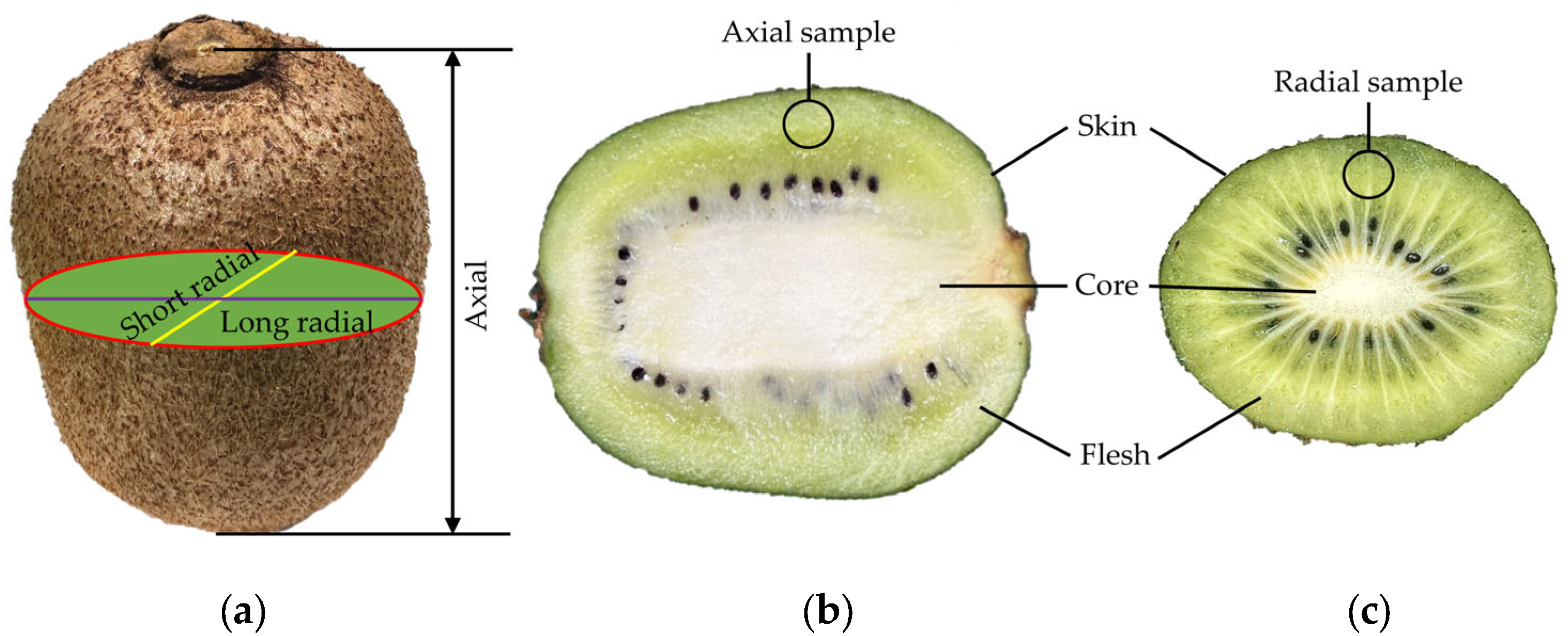
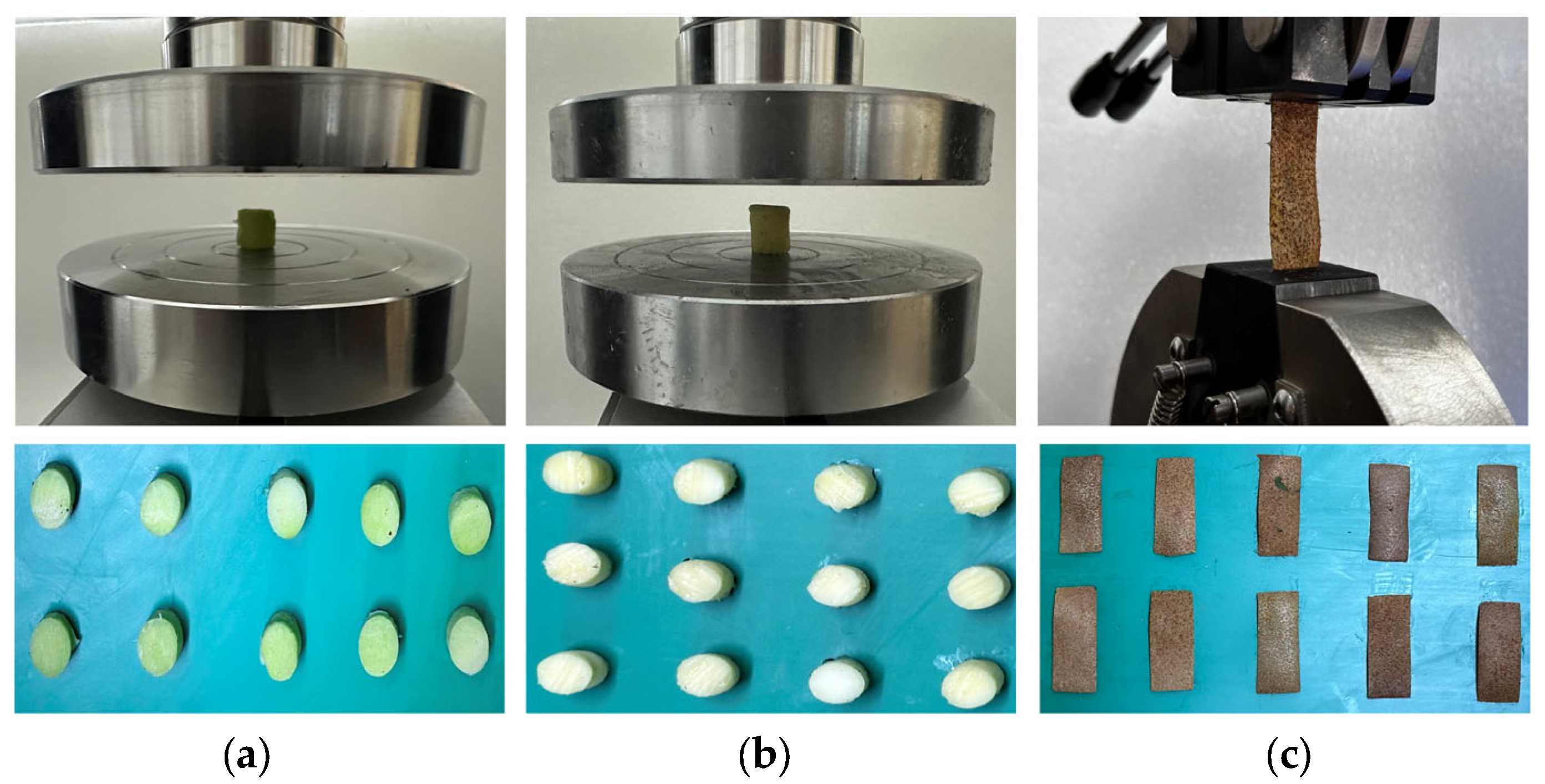
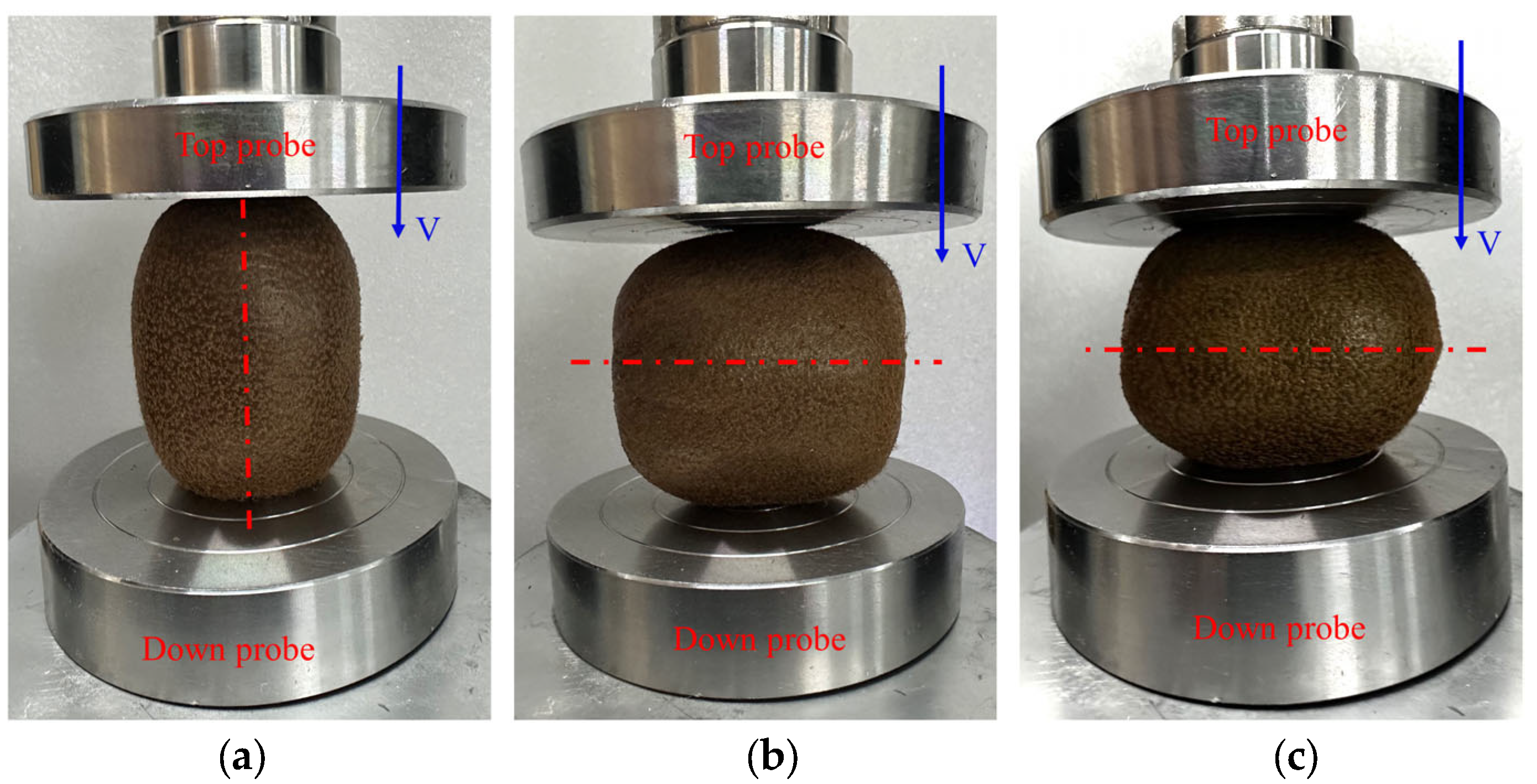


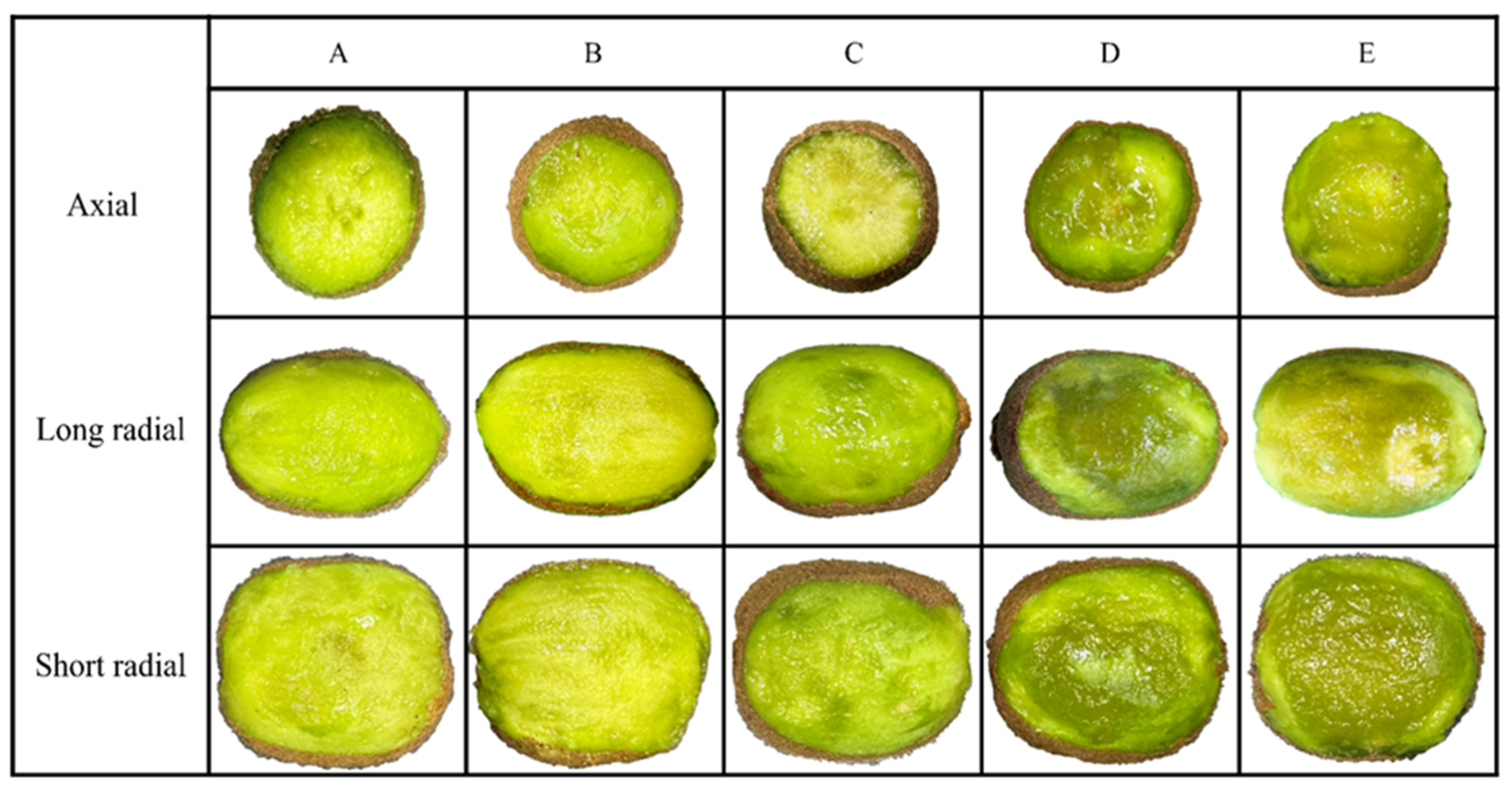

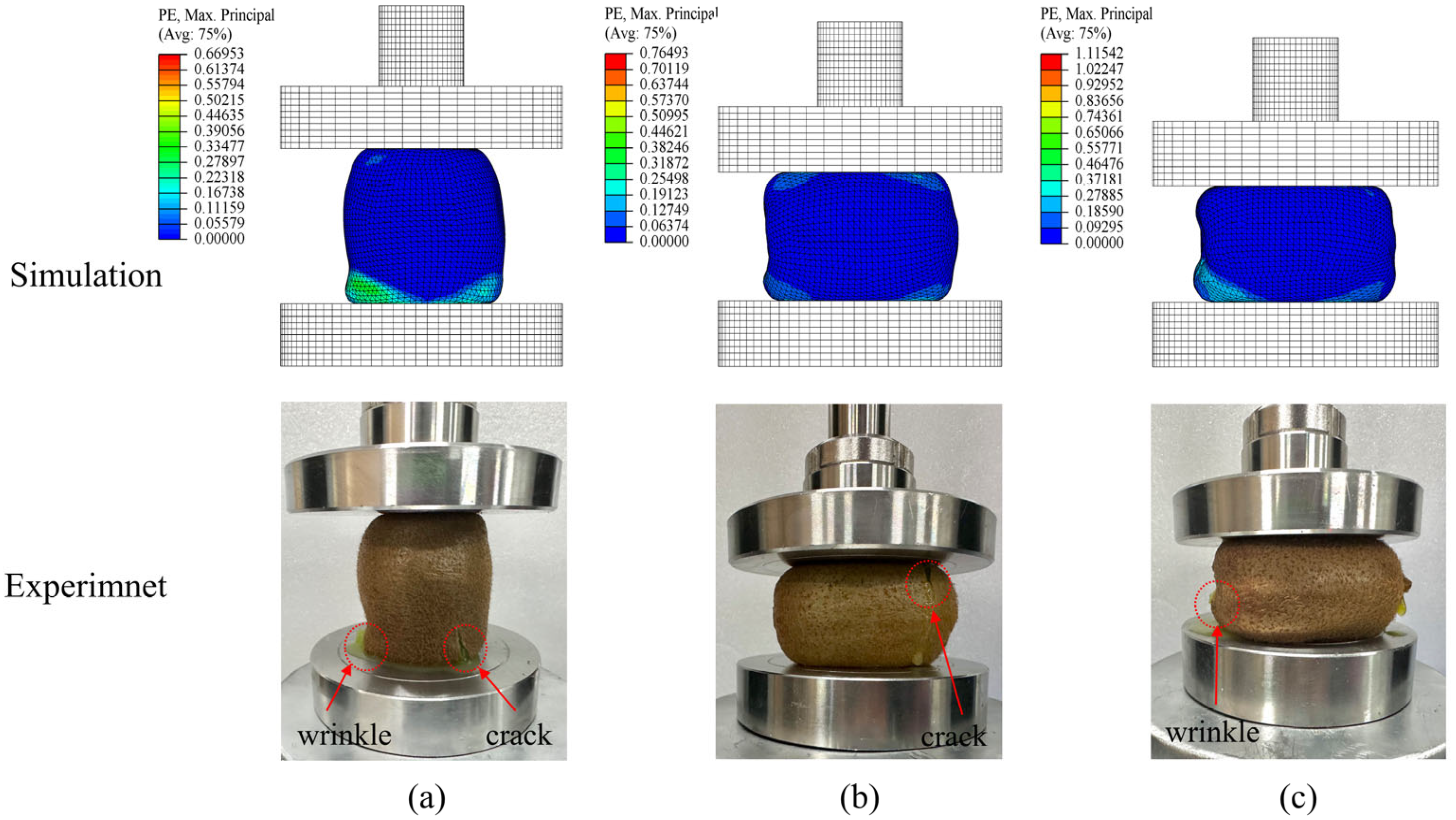


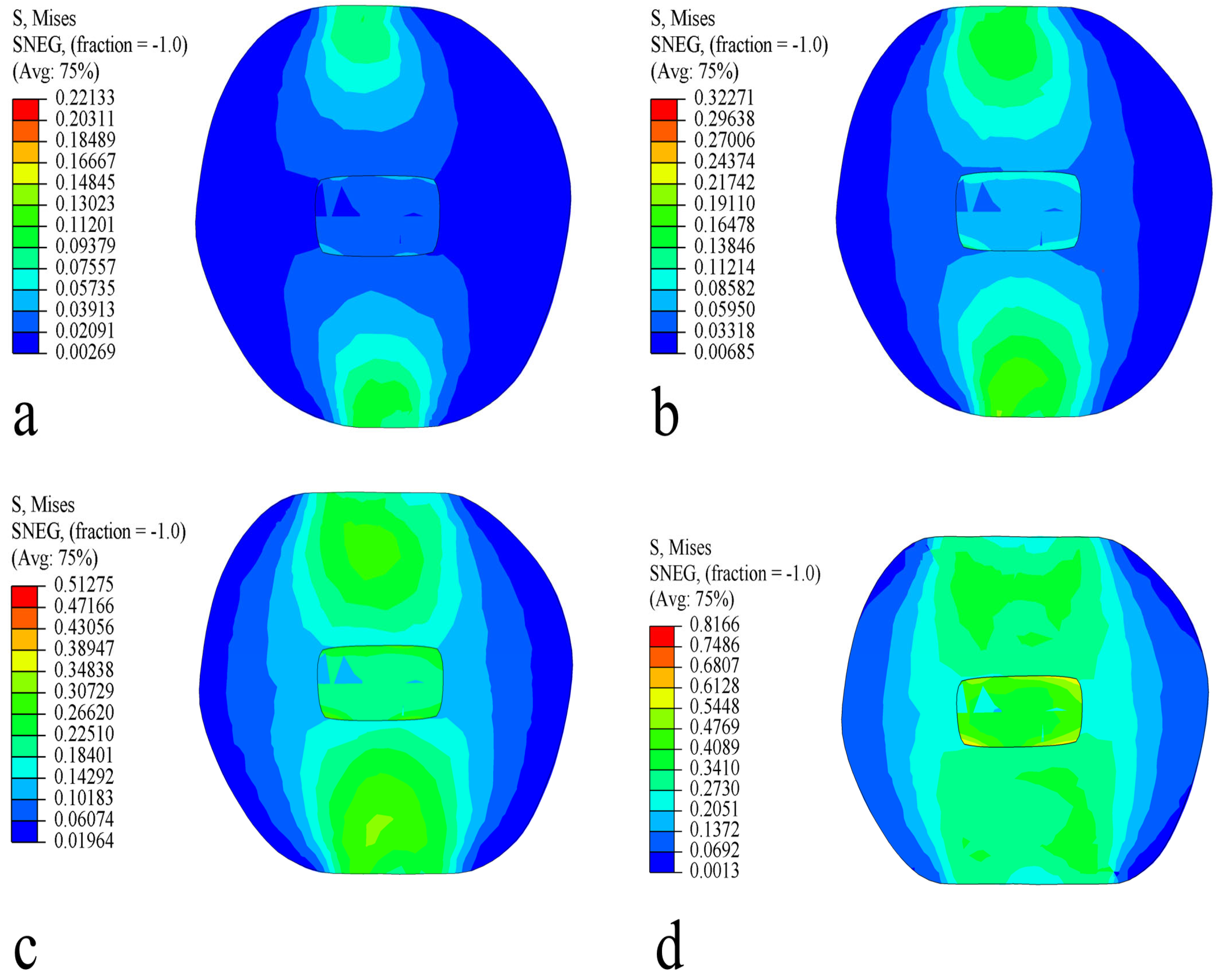
| Materials | Young’s Modulus (MPa) | Tangent Modulus (MPa) | Bio-Yield Stress (MPa) | Density(g/mm3) | Poisson’s Ratio |
|---|---|---|---|---|---|
| Skin | 10.233 | ─ | 0.514 | 0.551 | 0.30 |
| Core | 4.499 | 1.381 | 1.306 | 1.154 | 0.30 |
| Flesh Axial | 2.305 | 0.967 | 0.491 | 1.248 | 0.40 |
| Flesh Radial | 1.346 | 0.642 | 0.292 | 1.248 | 0.40 |
Disclaimer/Publisher’s Note: The statements, opinions and data contained in all publications are solely those of the individual author(s) and contributor(s) and not of MDPI and/or the editor(s). MDPI and/or the editor(s) disclaim responsibility for any injury to people or property resulting from any ideas, methods, instructions or products referred to in the content. |
© 2024 by the authors. Licensee MDPI, Basel, Switzerland. This article is an open access article distributed under the terms and conditions of the Creative Commons Attribution (CC BY) license (https://creativecommons.org/licenses/by/4.0/).
Share and Cite
Zhu, Y.; Zhu, L.; Guo, W.; Han, Z.; Wang, R.; Zhang, W.; Yuan, Y.; Gao, J.; Liu, S. Multiscale Static Compressive Damage Characteristics of Kiwifruit Based on the Finite Element Method. Foods 2024, 13, 785. https://doi.org/10.3390/foods13050785
Zhu Y, Zhu L, Guo W, Han Z, Wang R, Zhang W, Yuan Y, Gao J, Liu S. Multiscale Static Compressive Damage Characteristics of Kiwifruit Based on the Finite Element Method. Foods. 2024; 13(5):785. https://doi.org/10.3390/foods13050785
Chicago/Turabian StyleZhu, Yue, Licheng Zhu, Wangkun Guo, Zhenhao Han, Ruixue Wang, Weipeng Zhang, Yanwei Yuan, Jianbo Gao, and Suchun Liu. 2024. "Multiscale Static Compressive Damage Characteristics of Kiwifruit Based on the Finite Element Method" Foods 13, no. 5: 785. https://doi.org/10.3390/foods13050785




